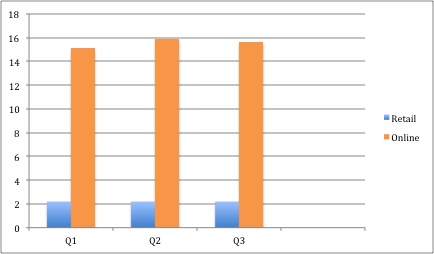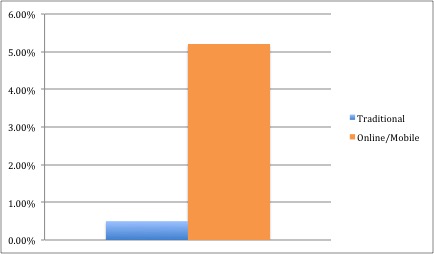By George Case
Faculty Member, School of Business
Now that we’ve completed Black Friday, Cyber Monday and the traditional holiday season, one trend is exceedingly evident. Online shopping, including online shopping with mobile devices, continues to increase in its share of overall retail sales.
In 2015, Internet sales rose 23%. By all accounts, this year will exceed that amount. According to the U.S. Census Bureau, the first three-quarters of 2016 saw retail sales grow at a rate of 2.2% each quarter over the previous year.
However, digging deeper highlights the continued growth of Internet sales. Sales in this area increased 7.9%, 8.1% and 8.4% respectively in each quarter. When you remove retail items that are not commonly purchased online, such as cars and gasoline, these numbers become decidedly more one-sided, increasing 15.1% (Q1), 15.9% (Q2) and 15.6% (Q3).
Traditional vs. eCommerce Retail Sales Increase, 2015 vs. 2016 (Q1-Q3)
Black Friday this year also highlighted the trend towards fewer retail sales from physical shoppers, as opposed to shoppers making online purchases. While total retail sales of $154 million was higher than the $151 million in 2015, fewer people shopped in stores (99.1 million vs. 100 million). Online shoppers increased from 103 million to 108.5 million.
Shoppers 2015-2016
Seismic Shift Occurring in Retail
Traditional retail sales are in what author and journalist George Packer calls, the “unwinding.” About 54% of consumers buy online every week or month.
What are retailers doing to address this shift? Retailers are focusing on controlling key facets of the Internet experience. They are engaging the consumer on different levels and platforms.
Controlling the interface that consumers see is an approach that is proving vital for retails. Take the role of the “reviews” section, which proliferates on websites. Approximately 67% of shoppers say that reading product reviews influences their buying decisions. That means that two out of three people are influenced in their buying decisions by reading the opinions of other consumers.
Consumers Now Act as Brand Ambassadors
Retailers are developing loyalty programs that go beyond simply giving discounts. Some programs seek to engage consumers and empower them to act as an ambassador for their brands, if customers choose to do that.
Customers feel a certain social status as a brand ambassador, so retailers should make it easy for consumers to gain exposure of their brands. For example, roughly 1.7 billion people use Facebook every month. If customers act as your ambassadors, they can reach a vast number of new customers via Facebook if they create a post that shows the use of your product.
Increasing Use of Mobile Devices for Online Shopping
Today’s marketing goes far beyond just retailer websites. Omni-channel retailing is no longer an option, and the experience must be seamless between the different platforms.
For instance, 91% of Facebook users have access to a mobile device. That’s a potential target audience of 1.55 billion people.
However, mobile marketing has its challenges. The screen sizes of mobile devices dramatically vary in size. Marketing messages must be adapted to look good on any electronic device, whether it’s a 55-inch big-screen television or the two-inch screen of a mobile device.
Approximately 34% of shoppers agree mobile devices will become their primary tools for making purchases. Facebook’s Nichols Franchat boldly states we are entering a mobile-first retail environment.
Mobile shopping has definitely altered online purchasing and consumers are using mobile devices more and more due to their convenience and portability.
Digital Native Millennials Forcing Changes in the Shopping Experience
Millennials are driving much of this change from traditional marketing. They have forced retailers to place emphasis on their preferences, such as easy check-out and seamless channel integration.
Millennials also value knowledgeable shopping assistants. This assistance can be a retail store’s flood salesperson, such as Best Buy’s Geek Squad, or an easy-to-use online guide.
To accommodate the demands of shoppers, a floor salesperson now must act as a help call center. He or she must possess a vast amount of knowledge.
The trend continues away from the traditional retail format as the Internet increases its power and influence. The shifts to online and mobile technologies will require all retailers to create and implement an effective and meaningful relationship on numerous interfaces.
Omni-channeling must become one of the core competencies a retailer masters. We don’t know what form the customer interface will take in 10 years, but we do know that successful retailers will be pioneers in implementing their omni-channel programs.



Comments are closed.